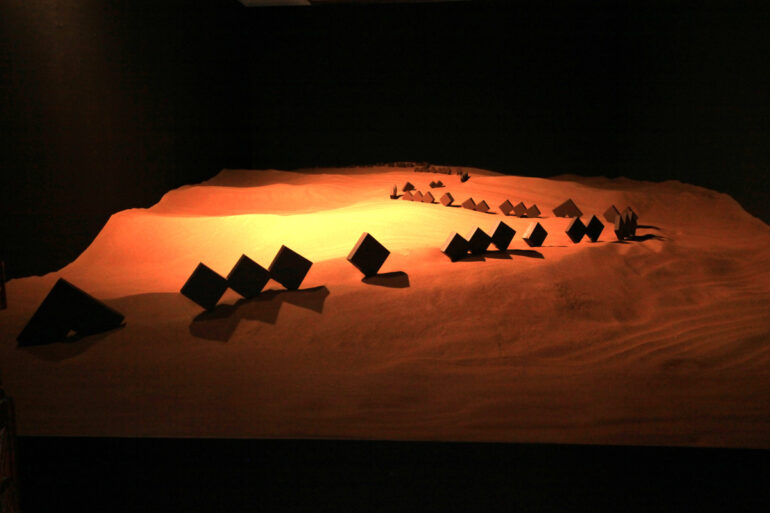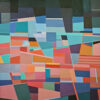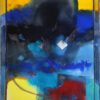At the start line, before hitting the bumps and the tragic spurts, childhood memories lie, and for artist Jamal Habroush Al Suwaidi, those memories were the fiery sparks that led to what he became. his great grandfather; of Al Bateen, Abu Dhabi, was a Falconer, a profession that carries its own weight in epistemology, taste, and life. A Falconer was superior in walking, this is due to the infinitely vast nature have constituted the visual and moral sum of his lifestyle, a life that is a sum of constant movement and philosophic existential coincidences, along with the amazement that is paired with both agony and joy. those were crucial features of his grandfather’s life that then was passed on to his father, who was also a traveler, tourer, and wanderer so that his days were in rhythm with merchandise and its obligatory needs of constant moving as well as dealing with all kinds of colors, fragrances, and shapes. sadly, his father’s journey was cut short by his passing away, two weeks before the born of his son, Jamal.
Years after that tragic death, the young boy got to learn its circumstances. his father contracted a fatal disease, and fell victim to a merciless bacterial attack. he even came to realize the dramatic funeral his father received, in which those who held it kept people away fearing the attacks of the bacterial demon dormant in the deceased body, in an attempt to protect them from the fatal consequences had they come near the funeral.
That mental image lodged in the memory of “Jamal Al Suwaidi, who then was a young boy, as much the image of the desert of the Falconer grandfather, the seas of the merchant father, and the stories of his mother, all were greatly present in the young artist’s daily life, who will then get to continue the journey of his father and grandfather via his relationship with nature. he held great love towards the oceans and the laws that govern them, and moved around the winter deserts that are filled with colors and wanders. he conversed with the hills, plains, and mountains like wandering travelers. he adored the ruins and fossils, just like any archeologist whose breaths are taken with a passion for antiquities and relics.
This breathtaking passion for nature antiquities and phenomena has been, and still is, the creative motivation for the conceptual artist’s imagination who keeps coming up with a series of optical installation proposals. Nature has always been his number one inspiration. amidst the turns of the desert sand, he could see a coming statement that rushes to provide him with optical artistic outcomes, while the hazy place and the clouded vision in winter were the push for him to extrapolate the streaming meanings that lie behind the hills and heights.
The mixture of the auditory memory inherited from his mother’s stories, along with their extension deep in nature, and the vaguely familiar realizations, with the uneased ontological questions, have all joined to constitute a compulsory path for the young boy’s journey with all of its connotational and realistic steps. and as fate would have, first in the school with the emergence of artistic expressionism that grabbed the teachers’ attention, and later his participation with a painting in an exhibition for talents in the country and obtaining the award for third place at the exhibition… all of that while Jamal Habroush Al Suwaidi was still at a young age.
This marked the first, if fresh, turn, which the artist would later take as a sign, to build on it through epistemological and aesthetic knowledge of the oil painting and watercolor painting principles, along with photography and calligraphy. this multi-talent knowledge is reflected in his more mature contemporary artworks, where he applied a mixture of embodiment and abstraction, also of Hurufiyya and space, and of the color, with the connotations it signifies that derived from surrounding space.
The equation for the conceptual epistemological approach for artist Jamal Habroush Al Suwaidi could be summed up in the following scholastic sequence:
• The light and shades as being the energy for artistic vision, whose steps are paved down by light. here, we might notice that the artist does not deal with this physical fact only in the frame of its optical constants, but also via its transformations that are open to supernatural effects. in many of his artworks, there is a keen usage of light effects from technological sources similar to those of nature, setting the way for the idea and for the signification, without deferring the aesthetics of the subject and the conditions for optical balance.
• The 3-dimensional perspective, as the scale of vision resulting from the natural balance and the curves of its optical panoramic orbits. In this dimension, in particular, we get to experience that linking gap between the embodied and the abstract, so that no embodiment exists outside the borders of abstraction, and no abstraction is completely separate from the embodiment. the two-dimensional painting “length and width” stands witness to that in a folkloric way because the third-dimension perceived the painting as an illusion of depth, not a real physical depth. this is how we get to experience abstraction within embodiment, same as in every embodiment which could be the basis for abstraction.
Roger Garaudy, a prominent intellectual, wrote his important book titled ” D’un Réalisme Sans Rivages” back in the 60s of the past century, in which he refers to what we intend to say in this momentary approach.
• Anatomy as the dictating scale of all human and animal forms, emerging from the golden ratios, which adjust the balance and performance.
• Configuration as the element controlling the relationships between mixed artistic elements.
• Emptiness as the logical equivalent of crowdedness in a coordinated unavoidable integration.
Those academic vocabularies were always present at the basis and at the replication of his artistic vision that is constantly inclining towards conceptual installation arts, as we will come to see later.
After observing the Emirati artist, Jamal Habrous Al Suwaidi, experience for years, and since I first got to know him, I came to notice a prominent feature in his relationship with art, this feature, after thorough contemplation, could be summed up into two levels:
• The first level is represented by his organic relationship with the local environment, from which he derives the keys for his artistic vision and cycles.
• The second level is represented by the content of his artworks which have a comprehensive human message theme that is in practice embodied in his subjects that are filled with concerns, thoughts, and comprehensive human sentiments, such as happiness and sadness, fatigue and comfort, the visible and its symbols, which are absent in vision, yet present at heart… etc.
While we’re trying here to summarize the two levels of connotating optical vision in his artworks, it seems appropriate to contemplate these two levels in more detail, which overall constitute oceans in his visual texts, thus we might say:
One Whole Visual Unit
When it comes to the elements derived from the local environment, we might see that the Arabic letter was the exceptional motivation in a series of his artworks, to which the theme of “one whole visual unit” theme could apply, even if varied in appearance. the most prevalent example in that area is the letters “ح” (Haa) and “ب” (Baa), those two letters join to constitute the word “حب” (Love), thus introducing a musical abstract concept that is difficult to define, but paves the way for metaphysical artistic expressionism, in the sentimental sense of the word, so that love can only be defined as love, and the meanings laying within extend to cover all possibilities perceived materialistically and spiritually, in a space whose orbital identification grow to touch the hearts.
Artist Jamal Al Suwaidi expressed this meaning via the intertwining of those two letters and the integration of the two levels, by showcasing the dynamic features of the Arabic letters using two types of scripts; Diwani and Tughra, who belong to the family of standard geometric templates. he was also keen to utilize emptiness as a seeing and beautifying sign of the “Love – حب” model. hence the musical artistic collaboration between the flexible letter, the abstract embodiment, and the suggestive spaces, thus leaving the door wide open for variations in color and lighting, and paving the way for what I previously called the multi-faced “one whole visual unit”.
This experience will later reoccur, in a sum of aesthetic, optical, and signifying cycles, and leave the door wide open for other artistic proposals that both meet and scatter away from the letters modeling experience. this includes, but is not limited to, the experience of the fully rigged sail experience on the ship of the ancestors that is sailing towards its noble goal. this experience inspires its initial elements from the GULF environment which witnessed, over the course of history, harmony and an intertwining relationship with the sea as a source of food, hidden treasures, and a mean to move merchandise to and from Asia and Africa ports.
This time, the sail takes on a completely new theme, and merges with the comprehensive economic sense, that is because the dominant culture of the seas in the gulf water and its natural geography does not stop at the borders of the past, but extends horizontally in the modern world of merchandise that includes the major ports and free economic zones, and transportation in all of its forms; in sea, land, and air, and the economy of knowledge that introduces wild futuristic vocabularies.
One of his new proposals was also the “barrel” subject, which refers us directly to the oil barrel that carries what is called “black gold”… but the barrel of “Jamal Habroush” is coated with golden color, and on the surface, it is aligned as the pearls, or even as the alignment of piano keys. this is why the barrel artwork comes parallel to the piano matrix. the artist even goes as further as to assume that the barrel of oil acts as the G clef that regulates the musical notes… just as the barrel of oil regulates the global economy.
In the 70s of the past century, simultaneously with October War and the victorious march of the Egyptian armies in Sinai, back when Arab solidarity was at its peak. the rulers of the monetary management institution Bretton Woods realized the deadly weapon that is oil which Arabs have, back then, Henry Kissinger, the former secertrary of state, made his move towards the Arab world, waving his new global financial project, betting that considering oil to be the black gold must be connected with the dollar centrality in the currency exchange market.
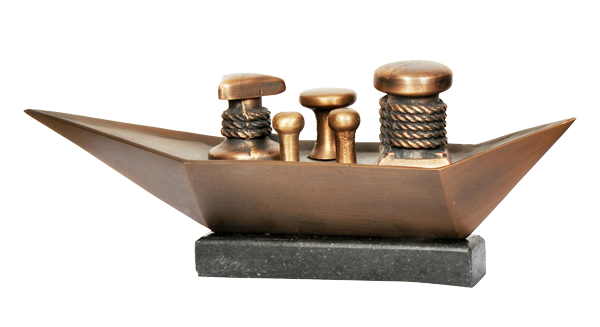
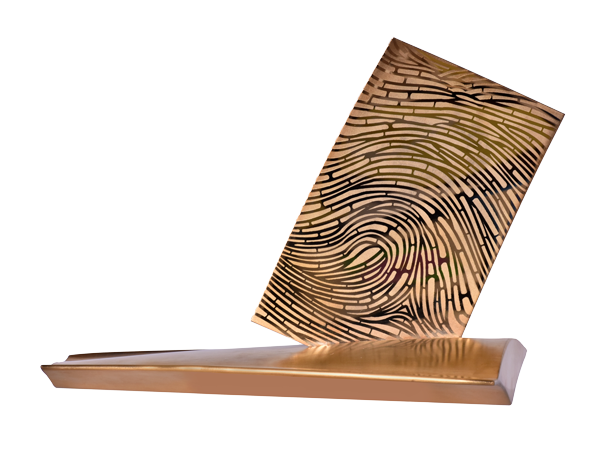
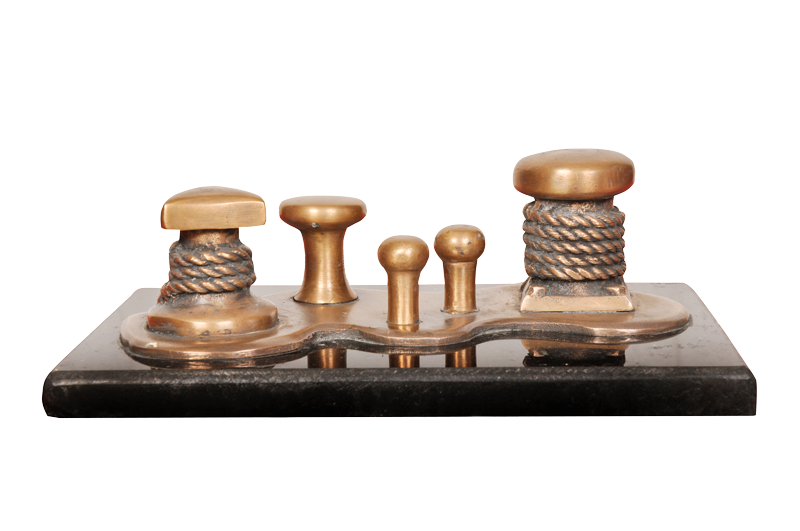
The project, at the first glance, seemed delightful to Arabs, since oil will be regarded as black gold from now on, but what it actually meant is that oil would gain its golden potential from being inversely related to American currency, then the dollar would regain its golden standard that it lost, it will even become the good luck charm for the oil price, and a new term would invade the world of finance and business which is ” Petrodollar”, meaning that the higher regulator of the black gold is the petrodollar, and the name alone signifies that oil is subsidiary to the dollar.
this subsidiary state would later encompass the global exchange system, and the whole Global financial system which has to understand the central position that the USA has in the world economy being the largest economic force in the world.
These referential retrieval attempts are clearly prevalent in the artist’s golden barrel of oil production, which will later transform, in a subsequent dramatic analysis into the piano keys that are played locally, regionally, and internationally.
Local tributaries in the human skies
This sequence of connotational references is a general theme in the artist’s productions, yet it varies between subjects, with clear inclinations towards wholistic-themed issues, as is the case in the subjects of love, agony, happiness, pain, and pleasure, and all the artistic variations that take us far away to wholistic topics, which in sum constitute topics and contributions from the local tributary, to find its artistic and aesthetic legitimacy in the global project of the human art.
If we were to summarize the features of his artworks in more detail, we could discuss the following:
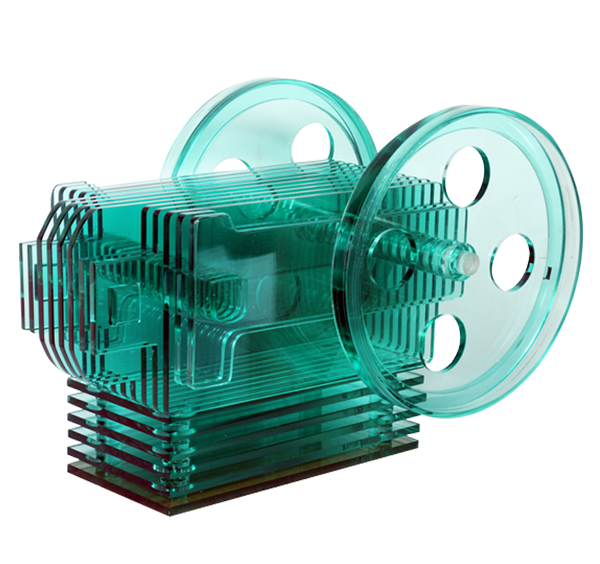

The Arabic letter
The Arabic letter wanders the halls that the artist creates following the geometric balance on one hand, and the mathematical algorithm on the other, one that surpasses the geometric balance to the abstract intonation. this is due to the fact that the relationships between Arabic letters are aligned via golden geometric ratios that cannot be disregarded, and the statement of these geometric standards is fully explained in the texts around Arabic calligraphy essence, or even go further to say that it applies to all the scripts in the world, which in core comes from the audio input that is transformed into an entity, so that the letter can speak amidst its silence, move amidst its stillness, and find balance amidst its fluctuations. looking at it, particularly from this angle, could reveal the artist’s keen effort to express the dimensions of embodiment and abstraction in his calligraphy art productions, and how those productions extend to include transformations in shape and in color, while remaining crystalized at the basis of the initial visual unit.
The local environment
Artist Jamal Habrous Al Suwaidi has chosen a fixed position within his local environment, completely reassured that it is the brightly clear source of his vision and artistic choices, but with a horizontal presence in the human artistic inputs, with both its historic academic form and the dynamic modern one. we get to experience this dualistic truth with the artist via the matrix of his art pieces that are drawn upon the implied retrievals of the historic art of sculpture, with a modern inclination towards the new and the newer, so much that we could describe some of his artworks within the context of conceptual installation and assemblage arts, in which he used “audio-visual” special effects. an example of that is the passing camel train moving in the desert, which he was keen to introduce within a panoramic method lit with the desert lights and the realistic third dimension, with reduced symbolization of elements. his participation in Sharjah Biennale came in line with that, via the space of the green-lighted room, with the possibilities of leaping perception and moving from one phase to another, and to me, the transparent ambiguity seemed like a significant feature in this conceptual processing that extends to the borders of perplexity.
Dr. Omar Abdulaziz holds a doctoral degree in Philosophy and Economic Sciences. He has authored more than 40 publications in the fields of intellect, criticism, novels, and aesthetics. Additionally, Dr. Omar is a visual artist, having held personal exhibitions and participated in events both in the Arabian and international contexts. Beyond his contributions to media and culture management and planning, he has held various leadership roles in these domains and actively participated in academic programs at several universities.
Currently, Dr. Abdulaziz serves as the Head of the Department of Research and Studies at the Department of Culture and Information in Sharjah. Moreover, he holds the position of Chairman of the Board of Directors at the Arab Cultural Club.

